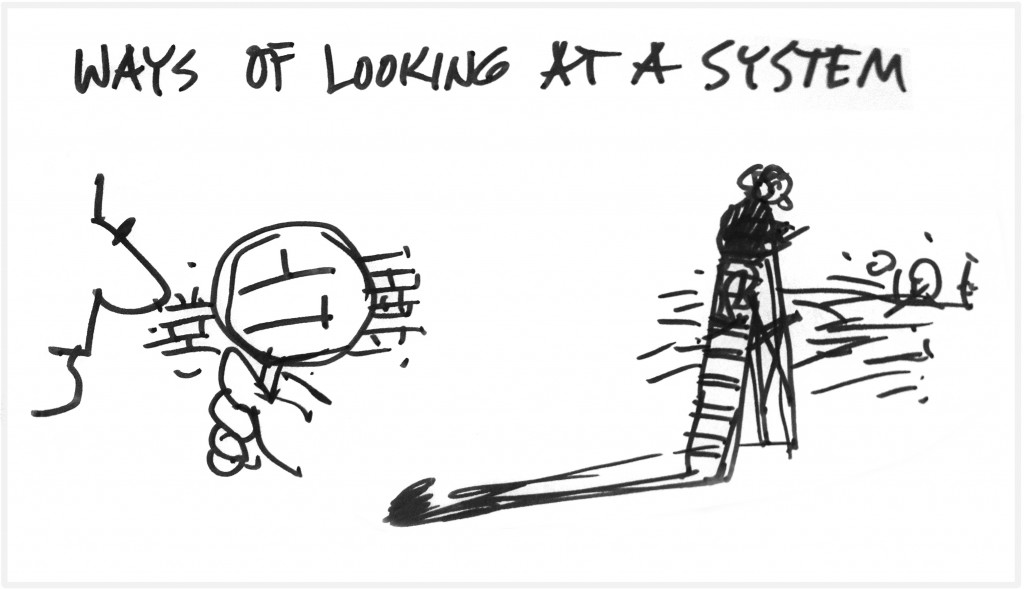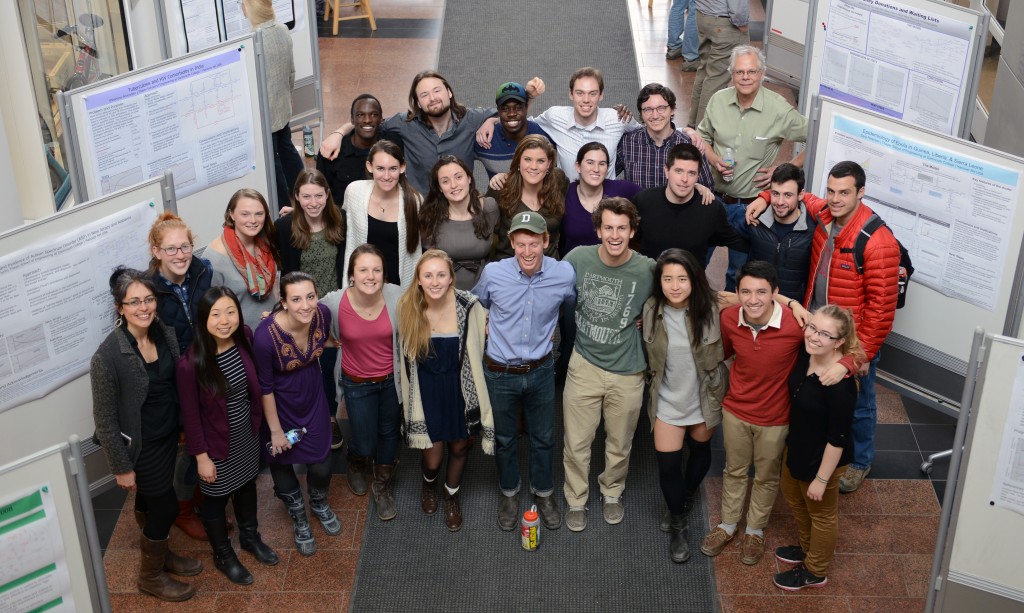We live in a world of remarkable, adaptable, complex systems. They are inside of us and all around us, from the tiny system of a single cell to the vast systems of the world’s oceans and our global communications networks.

Systems can be examined by zooming in to look closely at their stocks and flows and other component parts, or by zooming out to see the entire system as one interrelated whole. This sketch by David Macaulay illustrates the two approaches, both of which we found useful.
The problem with complex systems, though, is that it turns out we human beings are not much good at recognizing, understanding, or communicating them. We often see individual items where we should see elements of a system, we attribute a problem to a single effect, and we approach issues with narrow horizons of time and space.
Still, despite our natural shortcomings with systems, learning to understand and redesign them may be the best approach we have to tackle the increasingly large and complex issues facing our world today, from climate change to wealth inequality to energy security.
Here at the Donella Meadows Institute, we have long used systems thinking as the lens through which we’ve addressed issues of environmental and economic unsustainability. But over the past few months, we’ve had the opportunity to slow down and really focus on it as a tool and an approach. We found ourselves both surprised and encouraged.

On the final day of our systems dynamics class, each student presented his or her model at a project symposium. (Image via Thayer School of Engineering at Dartmouth)
Like many things, systems thinking is a skill. It can be learned and practiced and refined, and so, this past winter, Marta and I returned to school as students in a systems dynamics course at Dartmouth’s Thayer School of Engineering. Taught by Steve Peterson, a former student of Dana Meadows’s, “System Dynamics in Policy Design and Analysis” was a gritty and engaging introduction to systems. And it only took us about halfway through the first lecture to see for ourselves just how complex and unintuitive the subject could be.
As an introductory example, Professor Peterson presented a very simplified stock and flow scenario: A company has experienced employees and employees-in-training. Every time an experienced employee leaves, a new employee is immediately hired to take his/her place. It takes 6 months to fully train a new employee. If the leaving rate for experienced employees has been constant for a while, but it suddenly jumps up to a higher rate, what will happen to the number of experienced employees in the company over time?
Only about one third of our class came up with the correct answer to this comparatively simple systems problem. And it seems that our group was no anomaly. Indeed, in the paper “Why don’t well-educated adults understand accumulation? A challenge to researchers, educators, and citizens” (Cronin et al, 2009), systems researchers found that well under 50% of graduate level students from MIT and Harvard could correctly answer stock and flow questions about a similar example. As the authors explained, “stock–flow failure is a robust phenomenon that appears to be rooted in failure to appreciate the most basic principles of accumulation, leading to the use of inappropriate heuristics.” In other words, most of us are confusing stocks and flows, the basic building blocks of systems.
Clearly, we have a lot of work to do to master these systems principles if we as humans are going to be successful in tackling complex and systemic problems.
At the same time as we were wading knee-deep through causal loops and feedback systems and STELLA software and the nuts and bolts of systems modeling, Marta and I were also submerged in these issues from the opposite end. In the classroom, we were systems students, but in our office, we are systems educators. This winter, we’ve been grappling with the best way to effectively communicate systems and, in particular, leverage points within those systems.

The Meadows Institute team brainstorming with illustrator David Macaulay about different ways to visually communicate leverage points and systems structures
In her popular article “Leverage Points: Places to Intervene in a System,” Donella Meadows described a hierarchical structure of interventions to alter the way systems work. At the very bottom of the hierarchy sit the constants and parameters in a system—numbers such as the quantity of cars driving on a highway or the level of subsidies being paid to farmers. These numbers may be visible and flexible in a system, but changing them rarely is able to change the way the entire system functions. At the top of the hierarchy, Meadows places leverage points such as the mindsets and paradigms that give rise to our society’s systems. We may not even recognize them most of the time, but if we can, changing these underlying structures can create deep and lasting changes in how our systems work. It’s a brilliant article and one that has inspired thousands of aspiring systems thinkers over the years. Our challenge has been to present its wisdom in ways that can be understood and applied by those without any systems training.
Tackling these two tasks together—learning to model systems very precisely in our class and learning to communicate systems visually in our office—proved to be a bit of a system example in itself. In many systems, this one included, the concept of feedback is critical. Some feedback is balancing, such as a feeling of heat that causes your body to sweat and allows it to cool off. Other feedback is reinforcing, such as a feeling of anxiety that keeps you from focusing on the task at hand and therefore drives even more anxiety. In our case, Marta and I experienced a wonderful reinforcing feedback loop between our two very different systems tasks. As we developed our abilities to identify systems and model their structures and complexities, we found ourselves able to approach our leverage points project with fresh ideas and perspectives. In turn, focusing so specifically on leverage points and their power to shift systems allowed us to come at our class work with a keener eye for just these sorts of intervention points in the system we were modeling.
Of course, the learning did not stop there. Our systems dynamics class has come to an end, but we are only at the beginning stages of our work to communicate systems thinking concepts. Dana Meadows left us with such a treasure trove of her insights and approaches, and it is now our job to share them with as many people as possible. Perhaps, with new systems tools and a collaborative approach, we just might make some progress on the great systemic issues of our day.
By Sarah Parkinson







